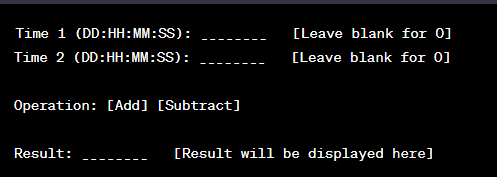Time Calculator
Add / Subtract:
Results:
Calculator Use
Certainly! If your time values are in the format DD:HH:MM:SS, where DD represents days, and you want to add or subtract them, you can use the following calculator. If any input field is left blank, it will be considered as 0 by default.

Please input the time values in the format provided, choose whether you want to add or subtract, and the result will be calculated accordingly. If you have any specific requirements or questions, feel free to let me know!
Concepts of Time: Ancient Greece
Throughout human history, various philosophers and scientists have proposed diverse concepts of time. One early perspective came from the ancient Greek philosopher Aristotle (384-322 BC). Aristotle defined time as “a number of movement in respect of the before and after,” characterizing it as a measurement of change necessitating some form of motion or alteration. He posited that time is infinite, continuous, and that the universe always existed and will continue to do so. Aristotle’s view, one among many, set the stage for the later controversial discussions initiated by Sir Isaac Newton and Gottfried Leibniz.
Newton & Leibniz
In Newton’s “Philosophiæ Naturalis Principia Mathematica,” he treated space and time as absolutes. According to Newton, absolute time flows independently of external factors, termed “duration.” Absolute time is grasped only mathematically as it is imperceptible, while relative time is the human perception of “duration” through object motions. This Newtonian time contrasts with Leibniz’s view, where time only makes sense in the presence of interacting objects. For Leibniz, time is a conceptual framework for comparing and sequencing events, and it cannot be measured independently. The debate between Newton’s absolute time and Leibniz’s relational time, illustrated by the bucket argument, persisted for almost two centuries.
Einstein
Albert Einstein, credited for the theory of relativity, revolutionized theoretical physics. Unlike Newton, who viewed time uniformly for all observers, Einstein introduced the concept of spacetime, connecting space and time. In his theory, the speed of light, c, is constant for all observers, and space and time measurements change simultaneously for observers in different inertial frames. This perspective, distinct from Newtonian physics, explains phenomena like time dilation observed at near-light speeds. Einstein’s theory of general relativity resolves Newton’s bucket argument, emphasizing the role of geodesics in spacetime.
The evolution of time concepts across history demonstrates the dynamism of theories. Despite advancements in quantum physics, time remains a partially understood phenomenon. The prospect of challenging Einstein’s constant of light and achieving time travel continues to intrigue scientific inquiry.
The concepts of time, as discussed above, lay the groundwork for understanding the nuances of temporal calculations. These ideas have paved the way for advancements in the comprehension and manipulation of time, with applications ranging from physics theories to practical tools like a time calculator.
How we measure time:
Two primary methods for measuring time exist today: the calendar and the clock, both based on the sexagesimal numeral system (base 60). Originating from ancient Sumer and adopted by the Babylonians, this system simplifies fractions and contributes to its continued use. The development of seconds, minutes, and the 24-hour day involves the contributions of various civilizations.
In contemporary contexts, the understanding of time extends to practical aspects, including measurements and calculations. A crucial tool in this domain is the time calculator, offering a systematic approach to handling time-related operations.
The Egyptians, credited for dividing the day into parts with sundials, influenced the concept of a 24-hour day. Greek astronomer Hipparchus proposed equinoctial hours, leading to equal-length hours. Mechanical clocks in the 14th century popularized fixed-length hours.
As time measurement evolved, so did the need for efficient tools like a time calculator. The progress in defining standardized units and organizing daily activities further emphasizes the significance of precise time calculations in various fields.
While many calendar systems existed, the Gregorian calendar, introduced in 1582, corrected inaccuracies in the Julian calendar. It remains the globally accepted calendar.
The utilization of calendar systems involves intricate time calculations. Modern applications, including the time calculator, contribute to the accurate interpretation and manipulation of chronological data.
Early timekeeping devices:
Early timekeeping varied across cultures, with devices like oil lamps, candle clocks, and water clocks marking events rather than telling precise time. The pendulum mechanical clock, invented by Christiaan Huygens in 1656, regulated time through natural oscillation. Today, atomic clocks, using cesium atomic resonance, stand as the most accurate timekeeping devices, defining the second in the SI unit of time.
The historical journey of timekeeping devices underscores the need for accurate time calculations. From rudimentary tools to advanced technologies like atomic clocks, the essence of precise temporal measurements remains a constant.
Note: While the term “time calculator” is introduced in these paragraphs, it’s important to clarify that it typically refers to a practical tool rather than a concept discussed in the historical context.

Pingback: Unlocking Time Mastery with Our Responsive Time Calculator - Calculators Time
Pingback: Time Duration Calculator - Calculators Time